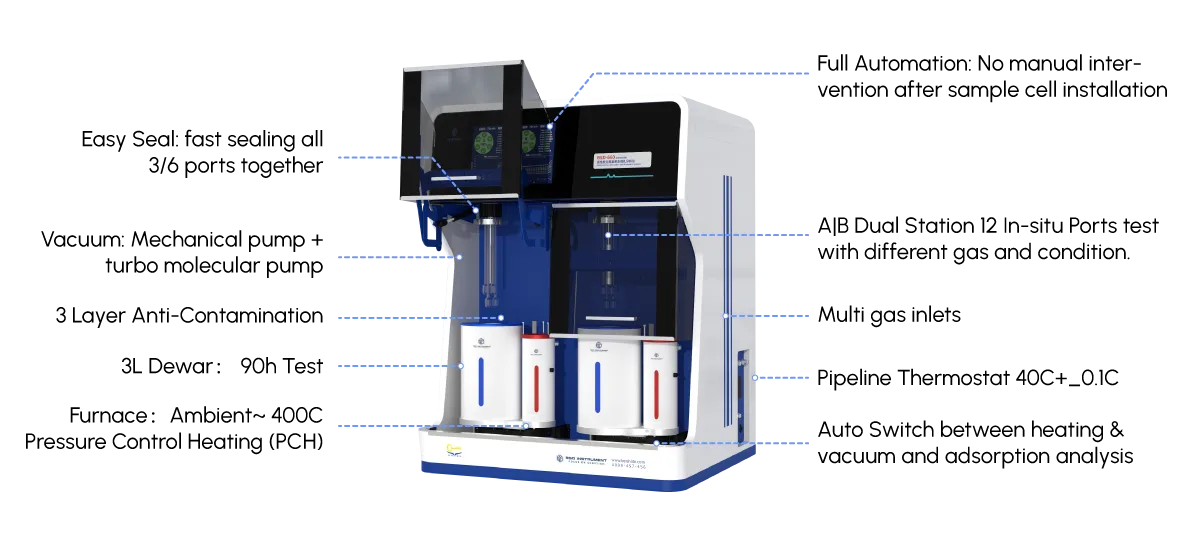Home / Blog / Micropore and Mesopore Analysis for Improving Gas Storage and Separation Efficiency
Micropore and Mesopore Analysis for Improving Gas Storage and Separation Efficiency
23 10 月, 2025From: BSD Instrument

1. Pore Size Classification
Micropores: < 2 nm Mesopores: 2 – 50 nm Macropores: > 50 nm
Micropores provide high surface area and enable strong interactions between gas molecules and pore walls, which is ideal for high-capacity adsorption. Mesopores facilitate diffusion and accessibility, allowing gases to enter and exit the material efficiently.
2. Importance in Gas Storage
a. Physical Adsorption Mechanism
High microporosity → High surface-to-volume ratio → Enhanced gas uptake per unit mass or volume. Example: MOFs like MOF-5 or HKUST-1 have shown exceptional methane and hydrogen storage capacities due to their microporous architectures.
b. Optimizing Pore Size for Specific Gases
Hydrogen (H₂, ~0.29 nm): Best stored in ultramicropores (< 0.7 nm). Methane (CH₄, ~0.38 nm): Fits well in micropores (~0.5–1.0 nm). Carbon dioxide (CO₂, ~0.33 nm): Can be selectively adsorbed in micropores over larger molecules like N₂ or CH₄.
3. Importance in Gas Separation
Kinetic separation (differences in diffusion rates) Thermodynamic separation (differences in adsorption equilibrium) Molecular sieving (blockage of larger molecules by small pores)
Common Applications:
CO₂ capture from flue gas (N₂/CO₂ separation) O₂/N₂ separation for medical or industrial use H₂ purification CH₄/CO₂ or CH₄/N₂ separation in biogas upgrading
4. Micropore and Mesopore Analysis Techniques
a. Gas Adsorption Analysis (BET & t-Plot Methods)
Brunauer–Emmett–Teller (BET) method: Measures specific surface area, mainly from nitrogen adsorption at 77 K. t-Plot or αₛ-method: Differentiates between micropore, mesopore, and external surface area.
b. Micropore Analysis
Determination of micropore volume and distribution is performed using: Dubinin–Astakhov (DA) or Dubinin–Radushkevich (DR) methods (for microporous carbons) Horváth–Kawazoe (HK) method (for narrow micropores in zeolites and MOFs)
Low-pressure N₂ or CO₂ adsorption helps characterize pores < 2 nm.
c. Mesopore Analysis
Barrett–Joyner–Halenda (BJH) method is applied to analyze mesopore size distribution using desorption branches of isotherms. Mesopores contribute to faster diffusion and accessibility of active sites inside the material.
d. Advanced Techniques
Small-angle X-ray scattering (SAXS) and small-angle neutron scattering (SANS) for structural insight. Transmission electron microscopy (TEM) for visualizing pore architecture. Molecular simulation (Monte Carlo, DFT) to predict gas adsorption behavior in model pore structures.
5. Material Design Strategies Based on Pore Analysis
Tailor pore size to match the target gas molecule. Optimize pore volume to maximize gas uptake. Enhance selectivity by creating molecular sieves or preferential adsorption sites. Improve mass transport by balancing micropores (storage) and mesopores (access). Functionalize pore surfaces (e.g., with polar groups) to enhance interactions with specific gases like CO₂ or H₂O.
MOFs can be synthesized with uniform pore sizes for precise gas separation. Activated carbons are tailored via activation processes to adjust porosity. Zeolites are ion-exchanged or modified to alter pore geometry and adsorption behavior.
6. Case Studies
a. Hydrogen Storage
MOF-177 has an ultra-high surface area (~4500 m²/g) and microporous structure, enabling significant H₂ uptake at cryogenic temperatures. Analysis via N₂ and H₂ adsorption isotherms reveals the contribution of micropores to storage capacity.
b. CO₂ Capture
Zeolite 13X and Mg-MOF-74 show high CO₂ adsorption due to favorable pore sizes and strong interactions. CO₂/N₂ selectivity is evaluated by comparing adsorption isotherms and analyzing micropore contributions.
c. Biogas Upgrading (CH₄/CO₂ Separation)
Porous carbons and MOFs with optimized microporosity selectively adsorb CO₂ over CH₄, improving CH₄ purity for fuel use.
7. Conclusion
Storage capacity Selectivity Adsorption kinetics Overall efficiency
Our Latest Blog & Articles
Stay updated with our latest news. Discover new product launches, innovative technologies, and upcoming events. Join our community and stay informed about all things lab equipment.
-
27 10 月, 2025
Cheap and Efficient Adsorption-Desorption Systems for Water Pollution Control in China
-
25 10 月, 2025
Gas Adsorption Analyzer Technologies: Advancements and Future Trends
-
23 10 月, 2025
Micropore and Mesopore Analysis for Improving Gas Storage and Separation Efficiency
-
20 10 月, 2025
Membrane Porosity and Its Impact on Mass Transport and Permeation Efficiency





